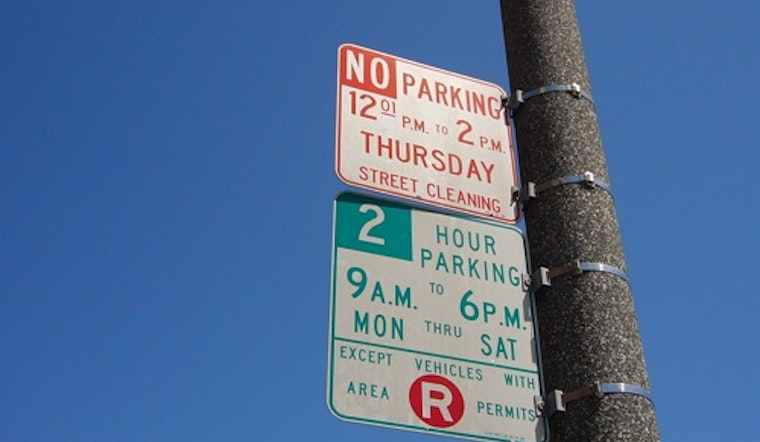
Once upon a time, not too long ago, Jeff was house-sitting for a friend in northwest Bernal Heights. For two days, he left his car parked near her house. On the third day, he awoke to find a handwritten note on his windshield, instructing him to move his car by the end of the day.
"It really weirded me out," he wrote on Hoodline. "Are there people keeping spreadsheets of familiar/unfamiliar cars and the days/times they park?”
The short answer is "yes"—and they're most likely part of a contingent of neighbors who have mobilized to establish northwest Bernal Heights as San Francisco’s 30th residential parking permit (RPP) area.
Two potential new RPPs—one in Bernal Heights, the other in the Dogpatch—are slated to go in front of the SFMTA Board of Directors early this summer.
But before they go up for a vote, the SFMTA is taking a fresh look at the 40-year-old RPP program to see what’s working—and what can be improved.
By The Numbers
First, a little history.
The RPP program grew out of a 1970s movement to improve safety, security, and improved quality of life for city residents by allowing them to easily access their cars, explained Kathryn Studwell, the SFMTA’s RPP program manager.
"The goal has always been to enable residents to be able to find parking close to their home,” Studwell said.
San Francisco’s first RPP areas, aptly named A and B, were established in 1977. Today, there are 29 RPP areas across the city, spanning roughly 77,777 permitted parking spaces. But few other changes have been made to the program over the past four decades.
According to data provided by the SFMTA, over 80 percent of today’s permitted spaces were added before 1990; since 2000, only seven RPP areas have been added. (One notable quirk: Bayshore residents voted to rescind their RPP zone in 2001, and the letter “Q” was recycled for a new area around Alamo Square and the Panhandle that was established in 2015.)
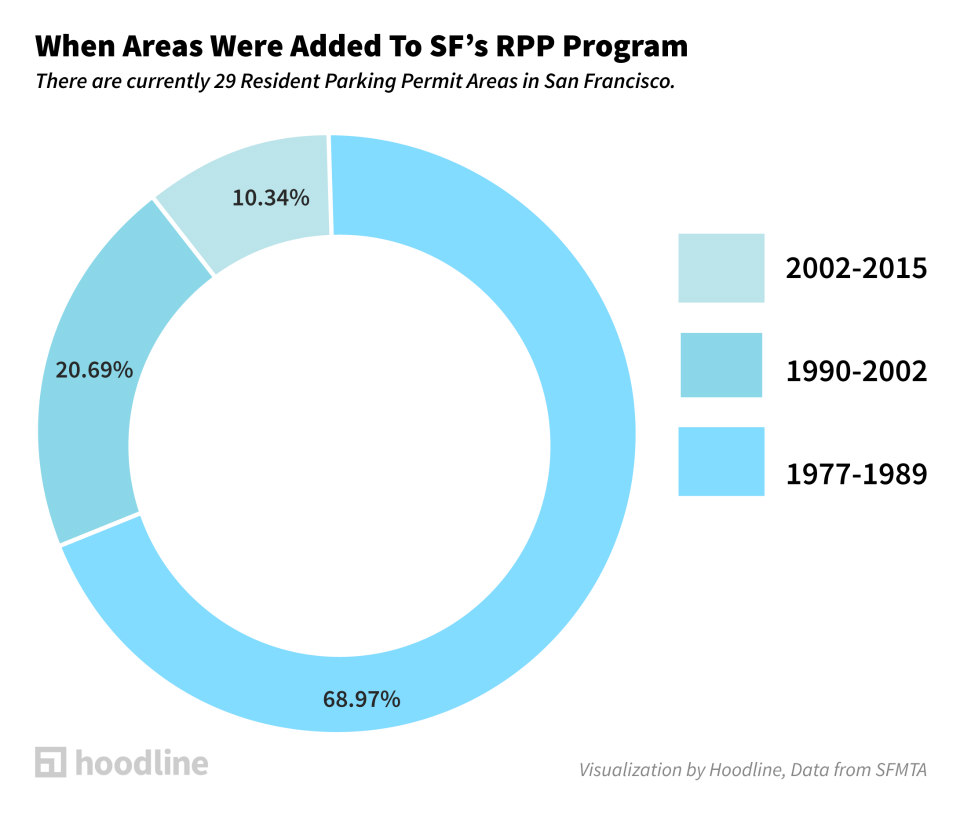
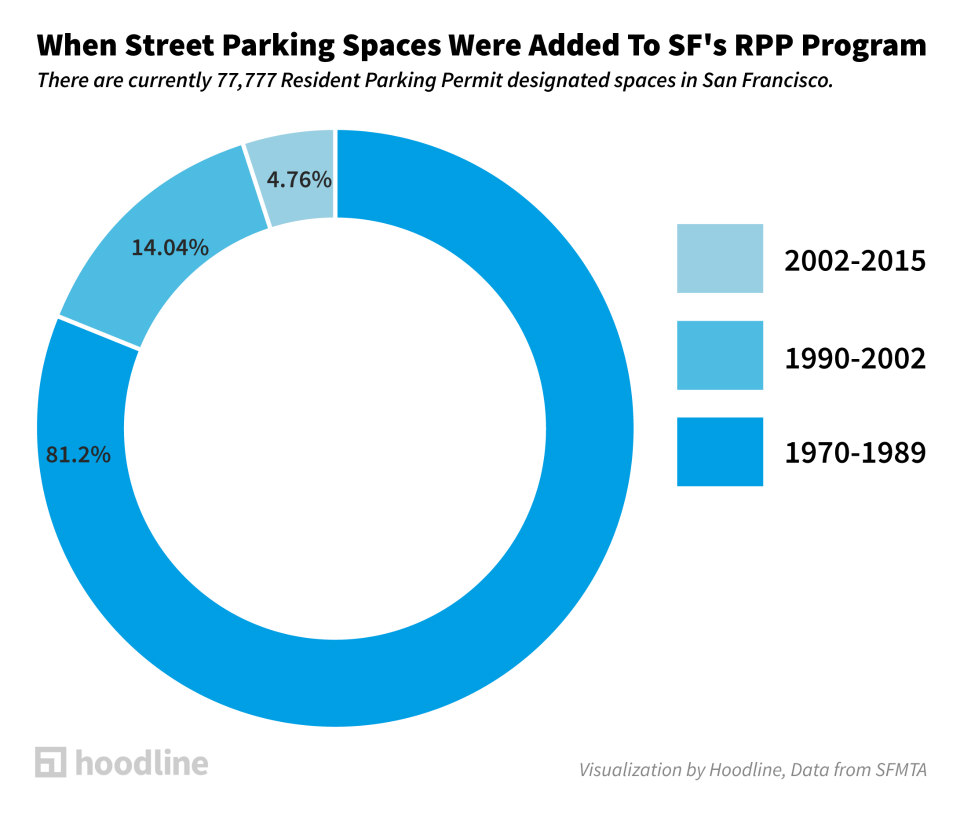
Why have so few RPP spaces have been added in the past quarter-century?
Hank Willson, SFMTA’s parking policy manager, told us that most of the “obvious spots” for permitted parking were incorporated early.
“When you look at the map,” he said, “the places most impacted by commuters coming from outside of an area to park their cars—big traffic generators like hospitals, universities and transit hubs—have already been covered by the program.”
Some potential target neighborhoods, like the Outer Richmond and Sunset, don’t have established RPP zones because they’re primarily made up of single-family homes with access to garages and ample street parking.
“One rule we apply,” Willson said, “is that a certain percentage of parked cars needs to be coming from outside the neighborhood. There’s no reason for someone from outside the neighborhood to park and leave their car at 43rd and Santiago.”
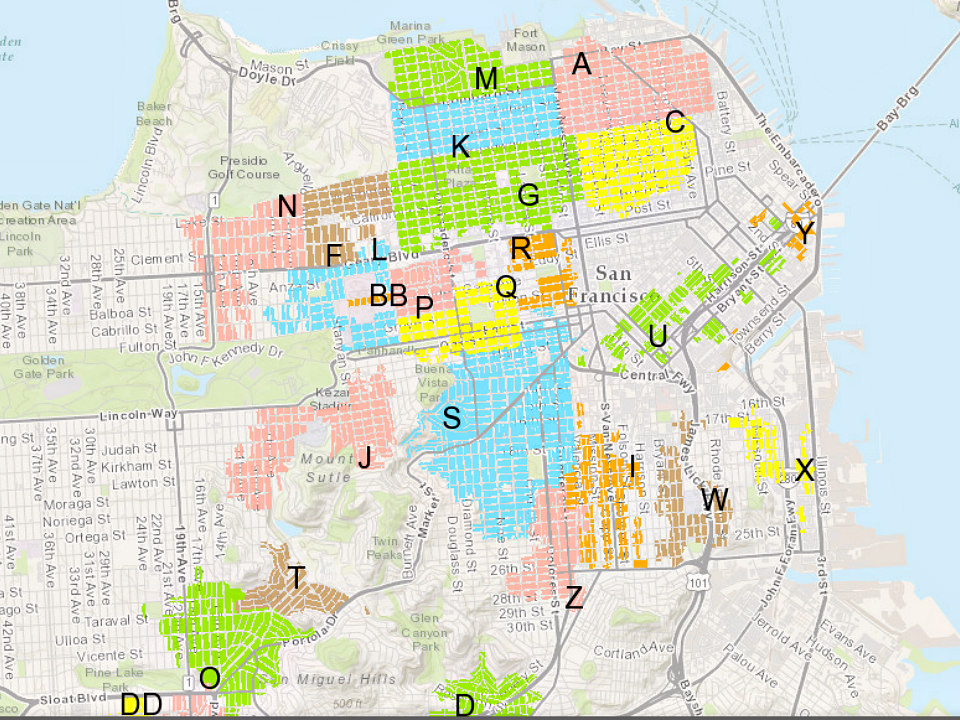
In the 29 designated RPP areas, SFMTA currently limits the number of parking permits per household to four. However, there is no cap on the number of permits the agency can sell, which means the number of permits for a given RPP area can exceed the number of available spaces.
This has resulted in 13 of the city's 29 RPP areas—nearly 45 percent—being oversaturated.
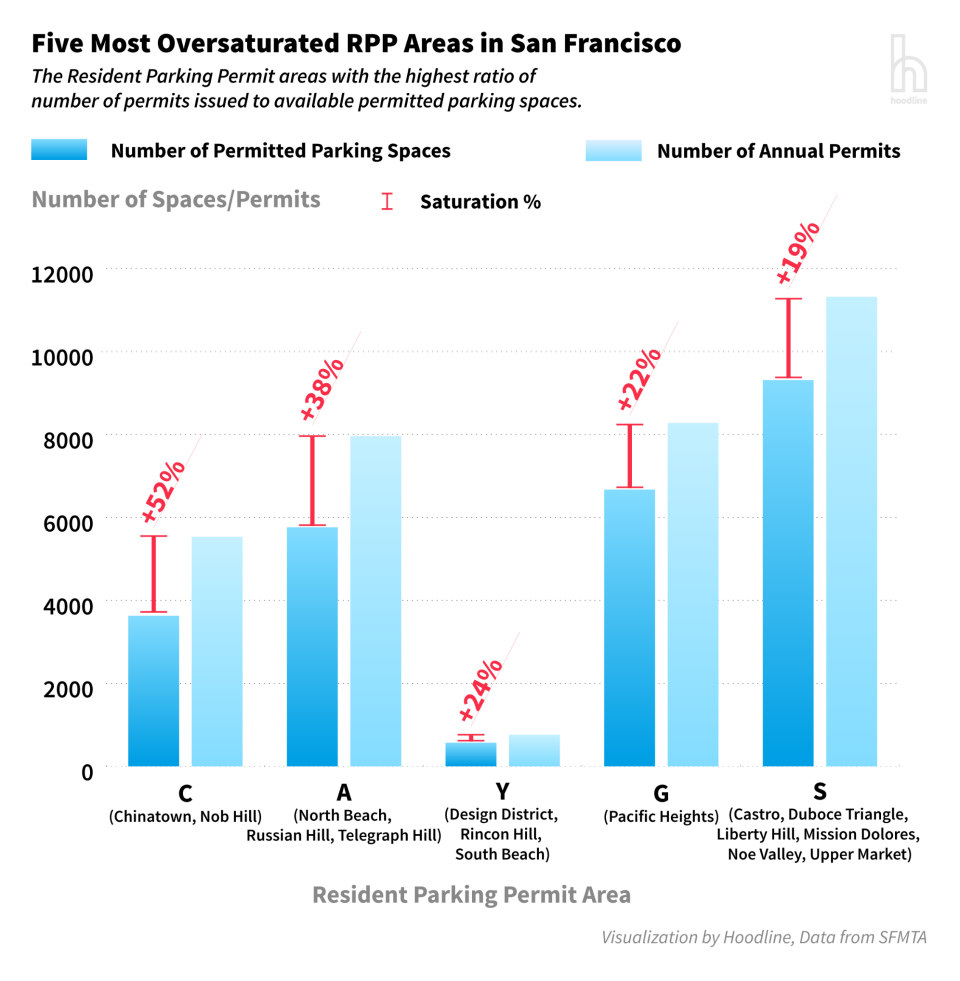
But six RPP areas in southwest San Francisco have the opposite problem—saturation levels that dip below 50 percent, seemingly creating a surplus of available spaces. Willson said the SFMTA isn't concerned about this.
“It’s not so much that there’s a huge parking crunch in those areas," Willson said, "If you give people free parking there, especially students, there will be an issue, but if you permit parking, people will take the train.”

Ultimately, oversaturated areas are a larger concern for the agency. “The RPP program is very effective at keeping people who don’t live in an area from parking their cars there,” Willson said. “But in places [like Chinatown and Nob Hill], it’s internal demands, rather than external demands, that are causing parking difficulties.”
Willson admitted that when the SFMTA continues to issue permits, regardless of the number of available spaces, it creates the same effect as having drivers come from outside of the neighborhood and leave their cars.
“We could stop issuing permits once we exceed a certain saturation level and start a wait list,” Willson said. “That’s what’s done in Toronto. They won’t give you a permit if there isn’t a space for you.”
How Can Parking Be Improved?
Three years ago, the SFMTA launched the Residential Parking Permit Evaluation & Reform Project. If it receives approval from its board in June, the agency will launch a pilot program in Bernal Heights and Dogpatch that creates some new limits on permits.
A few of the changes the agency is considering: limiting drivers to one parking permit; reducing the existing household cap from four permits to two permits; issuing an area-wide cap on the number of permits sold, to better reflect the number of spaces available; and adjusting the pricing scale for annual permits, to consider factors like permitholders' access to garage space and off-street parking.
SFMTA is also considering shaking up its policy around one-day flex permits, which allow out-of-town guests, non-residents and car-renting residents to purchase up to 20 passes a year to park in an RPP area. Rather than starting at $12 and gradually getting cheaper with each additional pass purchased, day passes would start at $6, increasing in price with consumption. (Update: SFMTA's Ben Jose told us that this was actually rolled out last July.)
For now, select recommendations will be limited to Dogpatch and Bernal Heights. But if the pilot is successful, they could eventually be rolled out across the city.
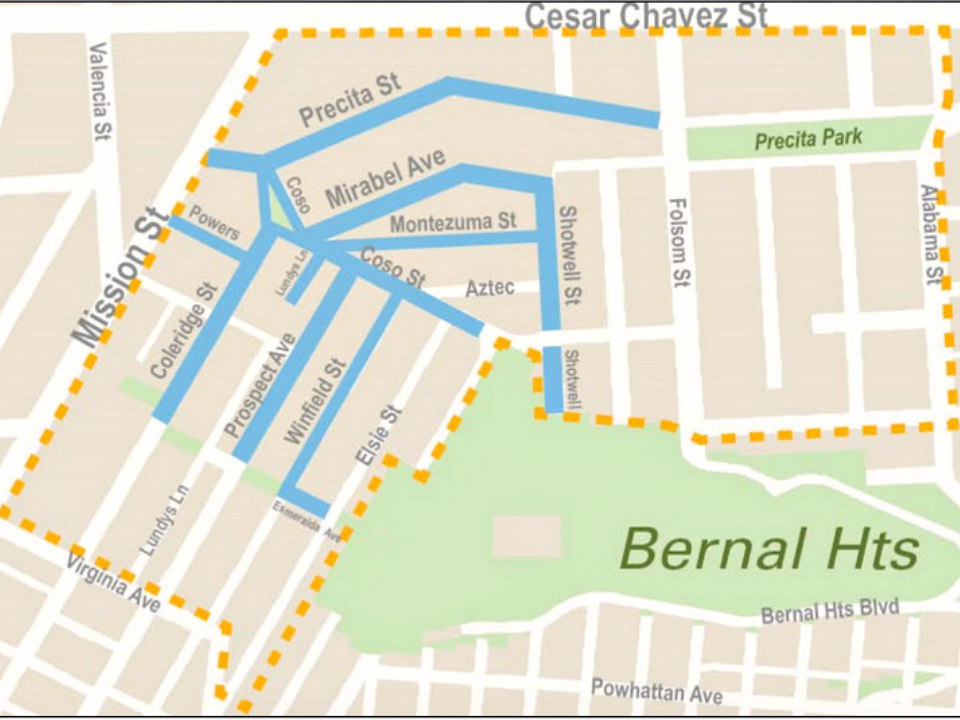
Bernal’s Heightening Parking Problem
Ellen DiGiacomo, who's lived on Maribel Avenue in northwest Bernal Heights since 1992, has witnessed the city's growing parking crunch firsthand.
When she and her partner first moved to the neighborhood, they owned four cars, and could easily park anywhere on the street. Although they've since downsized to two cars, she told us it’s become more challenging than ever to find a place to park them.
What's changed over the past 25 years? According to DiGiacomo, residents who own too many cars and neighbors who use their garages for purposes other than vehicle storage deserve some of the blame.
But her biggest complaint is with the number of non-residents leaving their cars on the streets of northwest Bernal.
“People park their cars, take their suitcases out of their trunk, get in a Lyft, go to the airport, and are gone for a week or two,” DiGiacomo said. “They know they can park on our streets.”
With no enforcement, a neighborhood watch has formed to have the non-residents' cars towed after five days, when they begin to violate city law.
DiGiacomo was one of the first neighbors to organize a petition to establish an RPP area in Bernal Heights.
“We felt like approaching the SFMTA was the only thing to do,” she said. “It’s the best solution to give back street parking to residents.”
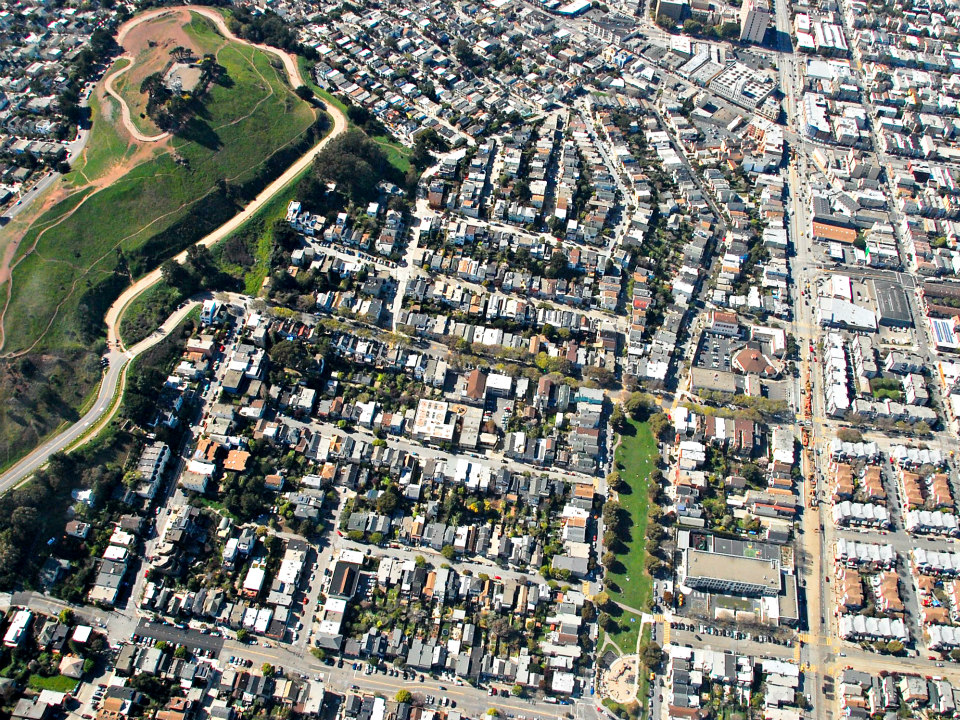
But not everyone believes that non-residents are scooping up Bernal residents’ coveted parking spaces.
As Bernalwood reported in December, the SFMTA's guidelines at the time stated that in order to establish a new RPP zone, more than 50 percent of vehicles parked in the given area must belong to non-residents. Agency data found that the number of non-residents parking in Bernal Heights was closer to 30 percent, well below the stated guideline. (Update: SFMTA's Ben Jose told us the Transportation Code allows for discretion, and SFMTA staff have traditionally used guidelines of over 80 percent parking occupancy, and more than 50 percent of cars registered outside the proposed area to guide that discretion. He said the area surveyed was larger than the proposed RPP area and the agency found that 59 percent of cars in the proposed RPP areas weren't registered locally.)
Since then, however, the SFMTA has published new guidelines for establishing RPP areas on its website, which make no mention of the 50 percent rule.
The change infuriated many Bernalwood readers. "I feel like I got conned," wrote one commenter. "SFMTA, you are rewriting the rules as you go."
But Studwell, the RPP's program manager, says that the number was never set in stone.
“50 percent wasn’t a requirement,” she said. “It’s a guideline.”
In the case of Bernal, Studwell told us that the agency reexamined its data, reconsidering the role of non-resident Mission drivers.
“We looked at the license plates of cars on the streets in question, and determined what percent are living on the block and what percent are not," she said. "The data changed—it’s more like 50/50."
It only takes 51 percent of households on a given street to vote in favor of establishing a new RPP, which risks leaving 49 percent of neighbors out of the loop.
When parking is packaged as percentages, made petition-able, and is politicized at the hyper-local level, tensions are bound to flare.

Like DiGiacomo, Brandon Powell also lives in northwest Bernal, although he lives on Aztec Street. He agrees that parking is an issue in the neighborhood, but he’s been opposed to establishing an RPP area from the get-go.
In addition to being annoyed that the SFMTA changed its guidelines halfway through the process, Powell believes that the agency has a vested interest in establishing additional RPP areas in the city, to collect more parking fines.
"Even though they say it's community-driven, they've been clear advocates of implementing the zone every step of the way," he said.
But the SFMTA disputes that argument, noting that the rate for an annual residential parking permit in San Francisco—$127—is capped by California legislation limiting it to the cost of administering the program.
"The RPP program has always been cost-recovery," SFMTA spokesperson Ben Jose told us. "Exclusive of citation revenue, it generates only the revenue needed to cover administration, policy and enforcement [costs]."
Nonetheless, the cost of a permit has increased by 370 percent since 2004, when it was below $30.
While Jose wasn't able to tell us if the cost of administering the program also rose that much over the past 13 years, the administration area hasn't grown significantly—only two RPP areas (areas Q and DD), comprising an additional 3,336 spaces, have been added since 2004.
And because there are consistently more RPP spaces than there are annual permits issued, SFMTA data shows that, on average, the agency has collected only about 75 percent of the money it could have potentially amassed from annual permits between 2004 and 2016—adding up to more than $16 million in permits that were never sold.
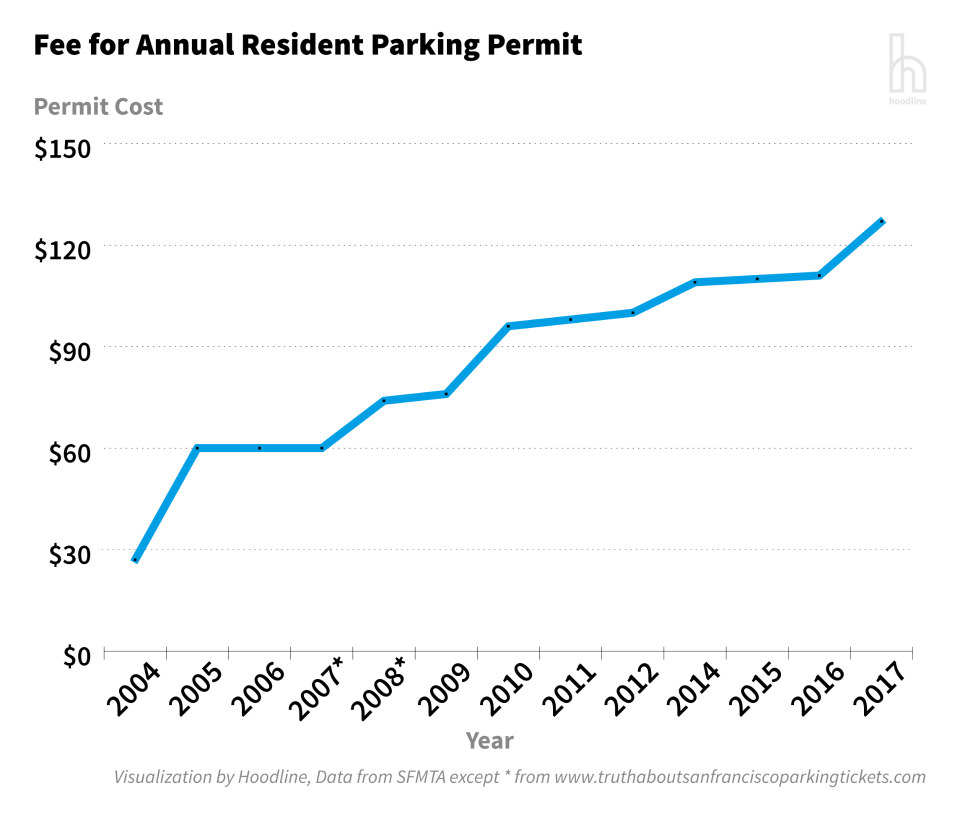
Administrative ambiguity aside, the city clearly stands to generate revenue through residential overstay citations—tickets handed out to drivers without permits who are parked in an RPP area for longer than the posted time limit allows.
In 2012, 149,985 overstay citations were issued, with payments totaling nearly $10.8 million in revenue for the SFMTA. According to SFMTA data, that number grew to 157,950 in 2014, bringing in more than $12 million to the agency.
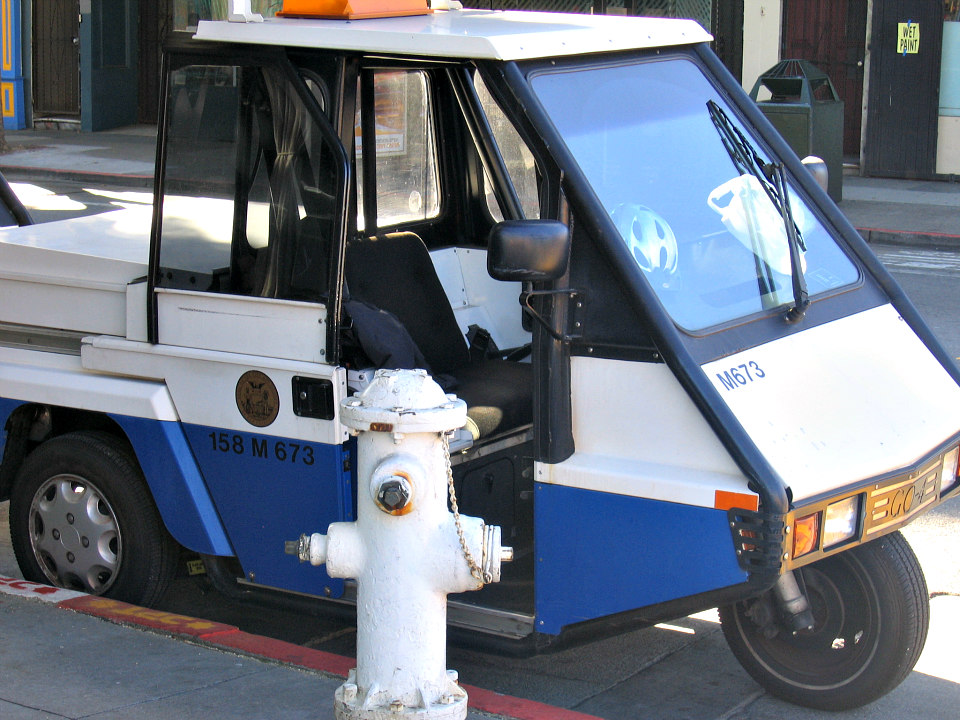
When asked about her agency's interest in establishing new RPP areas, the SFMTA's Studwell insisted that the process is community-driven.
“The only way we will ever [create new areas] is by working with the community to jointly determine the best approach to managing parking in that neighborhood," she said. “No one likes having something imposed on them. We’re only working with the blocks that want it. If neighbors want it later on, they can come in.”
But Powell, the Bernal RPP opponent, would prefer to see a solution that better tackles the "tragedy of the commons" created by street parking in San Francisco.
“I don’t have an issue with paying for parking,” he said. “But I have an issue when the city wants to give different access to what are essentially public goods. Everyone pays for the streets’ upkeep and policing—parking doesn’t belong to anyone.”
Powell argues that RPP areas don’t take into account how neighborhoods actually work. If the proposed Bernal RPP is approved, he won’t be included in the zone, as his neighbors on Aztec Street voted against it. That means that Powell won’t be able to park on the streets adjacent to his block, but neighbors in the surrounding area can park right in front of his house.
“These zones aren’t islands,” Powell said. “What you do on one street affects other streets."
"When you give residents the right to vote on what to do on their street, that’s great for them—but it doesn’t take into account me and my street.”
How do you think the SFMTA should update its 40-year-old residential parking program? Tell us in the comments below.









